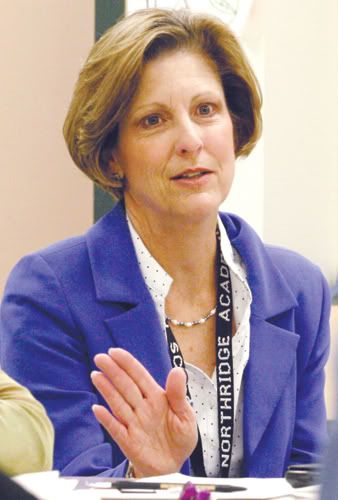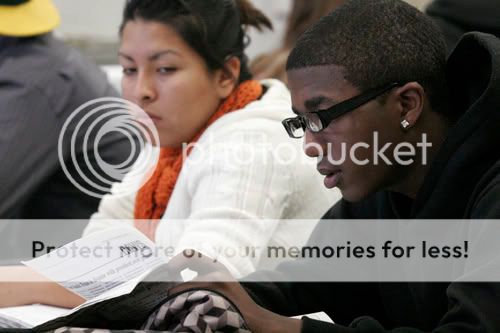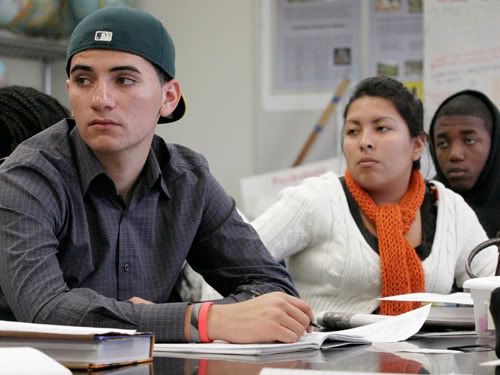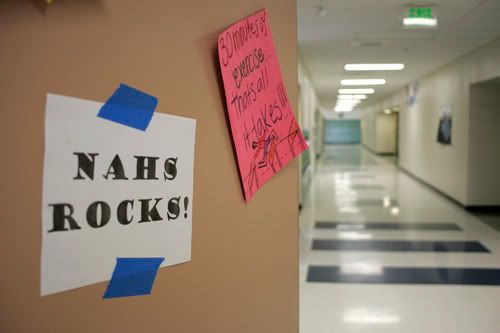 Green lockers line the halls of Northridge Academy.
Green lockers line the halls of Northridge Academy.
For many in college, high school is a distant memory of tedious work, unenthusiastic teachers and a curriculum that left many students asking the question, “Will I ever need or use this when I graduate?” But for Cynthia Rodriguez, a senior history major and a class of 2004 high school graduate, the memory of high school has been revitalized into recent memory, with a new twist.
Walking in the recently built classroom buildings and stepping into one of the classrooms to meet the faculty, you get the sense this is not your normal high school.
“I can get off my 12 o’clock class and walk over there,” said Rodriguez.
The “there,” Rodriguez is referring to is the not-so-normal Northridge Academy High School, a Los Angeles Unified School District high school located on Zelzah Avenue, adjacent to CSUN and wedged between the university’s tennis courts and parking Lot G7.
“This high school is a lot nicer than my high school,” said Rodriguez.
Nicer describes the overall aesthetic appeal of the?newly constructed high school that is made up of three buildings: a four-story classroom building, gymnasium, a multi-purpose room and underground parking garage located underneath the whole school.

Before the Sept. 9, 2004 opening of NAHS, visual appeal was not the only carefully detailed concept that has come to be associated with the high school.
“The school was built to alleviate overcrowding in other area high schools,” said Dr. Bonnie Ericson, chair of ?Secondary Education who serves as ?the CSUN liaison to NAHS and Teachers for a New Era NAHS Planning Committee Chair.
NAHS provided a solution for those students entering high school whose home schools were suffering from the effects of overcrowding. Presently, 60 percent of the students attending NAHS come from the areas allocated to Monroe High School, while 40 percent is evenly divided between Cleveland High School and Granada Hills Charter, said ?Connie Semf, principal of NAHS.
The high school’s sole purpose was not just to provide a source of relief for some of San Fernando Valley’s most overcrowded high schools, but has also served the purpose of fostering collaboration between the LAUSD and CSUN.
This collaboration between the school district and university was facilitated by a land swap that would give CSUN?a new parking lot and LAUSD a new site for a high school said Semf.
The second half of the agreement included the development of three smaller “learning communities” of Leadership and Learning Academy, Health and Human Development Academy and Arts, Media and Communication Academy. These academies correspond with three CSUN colleges, the Michael D. Eisner College of Education, the Mike Curb College of Arts, Media and Communication and the Health and Human Development College.

A direct byproduct of this partnership between CSUN and NAHS can be seen in the educational single-subject matter and teaching credential courses offered at CSUN. These courses use NAHS as a clinical site for secondary education observation. A relationship that Ericson said allows for an exchange between CSUN and NAHS.
“That would allow students in our student preparation to view a classroom and may allow students in the?high school to view a lab,” said Ericson.
The fact NAHS serves as a clinical site for CSUN students pursuing a career in teaching is just one aspect of a larger picture. NAHS is center stage for observation and research in developing new strategies for kindergarten through 12th grade education.
“We know there are serious problems in K through 12,” said Harry Hellenbrand, provost and vice president of academic affairs.
Hellenbrand said recognizing the challenges that face primary and secondary education, and attempting to solve those issues includes taking a closer look at teaching methods and prospective teaching candidates from the beginning.
Rodriguez is among the group of CSUN students who make the short journey to NAHS ?and get to view high school through a different perspective, while taking courses in the student-teacher program at CSUN. Rodriguez said her experience as a student-teacher at NAHS is one that has her remembering her high school days, while noticing distinctive differences.
“Just to see what its like for a teacher,” said Rodriguez.
These student teachers enter the high school campus to observe and participate in the teaching methods of secondary education. They also develop lesson plans and assignments under the supervision of a “master-teacher.” These student teachers are met with an environment many high school graduates, including Rodriguez, did not encounter in their own high school days.
Before the opening of the high school, a new and innovative technological tool was implemented to exploit and enhance the unique relationship between the university and high school.
The tool of choice is the two-way fiber optic viewing, which allows for both campuses to view each other’s classes through wired video sharing.
 A Northridge Academy student checks out the pages in the Daily Sundial newspaper as they prepare their pages for the science class newspaper
A Northridge Academy student checks out the pages in the Daily Sundial newspaper as they prepare their pages for the science class newspaper
The importance of the two-way video can be seen through the observing and reviewing of teacher candidates at the clinical site, digitally. This coordinates the efficient use of faculty and staff time and allows NAHS students to have access to events at CSUN. This could include, but is not limited to, lab classes, said Hellenbrand.
He also said CSUN and NAHS collaboration allows for research but also creates a “mechanism for cultural exchange.”
“Over time K through 12 and the university developed their own cultures, moving them apart,” said Hellenbrand. “This provides the ingredients to remix the cultures and unify rather than separate.”
Block scheduling integration, along side the university partnership, will also help transition students into college and develop a college going attitude, said Semf. Combined with the ability and easy access to the college campus without the red tape of field trip slips for the approximately 980 students of NAHS is another example of the collaboration. NAHS students and faculty have been able?to utilize the different events within a college culture.
“Our kids have had the opportunity to attend classes and special events at CSUN,” said Semf.
Despite the?two-way fiber optic viewing and readily available access to the university, Semf said they are?a “normal” compliance high school, which is a?true statement as?far as LAUSD standards permit. Yet, the fact technology was embedded into the high school’s cultural foundation is proof NAHS is different from other high schools, said Rodriguez.
“When I was in high school, teachers weren’t doing PowerPoint presentations everyday,” said Rodriguez.
Technology is not the only element that is setting NAHS apart from other high schools. The teachers are engaging the students with tools the students are familiar with, such as?the internet and blogs, all the while interacting with them on a more personal level.
“I think your going to hear the same thing over and over,” said Frank Ortega, a history teacher who
created a blog for his classes. “We are a small school, we can directly interact and address our needs.”
Ortega has 220 students, administers detention, sponsors the running club and conducts tutoring. Ortega said many other teachers at NAHS keep the same type of workload.
“We pride ourselves in being able to impact their social lives,” said Ortega.
In fact, the small school philosophy has deliberately created a support system that is ensuring continuity throughout a NAHS student’s four years of high school. This is intended to make sure all students have the same teacher at one grade or another, said NAHS history teacher Laurie Nelson.
“It’s so small we know what they’re doing,” said Nelson.” It’s a huge advantage.”
Nelson also said another advantage that NAHS provides for students and teachers alike is the amount of technology that is readily available to them.
“I don’t know how people taught without the Internet,” said Nelson, who also created a class blog for her students to access.
NAHS has more than just high-speed Internet access available. The majority of the classrooms are equipped with LCD projectors that can be used for school-wide video broadcasts. Another teaching and learning tool available in classrooms is the ceiling- mounted video cameras that can be used to zoom in on students’ projects and allow the teacher to review their class digitally.
 Students take notes as teacher Natasha Galdez lectures about editing as the students create their own newspaper layouts
Students take notes as teacher Natasha Galdez lectures about editing as the students create their own newspaper layouts
“It’s so much easier to have access to technology, everything is already hardwired, where it can be a pain at other schools,” said Nelson.
Nelson and Ortega are also both examples of teachers that have integrated?technology with education using blogs and PowerPoint presentations to engage the students, while continuing the small school philosophy.
Despite the advancements and benefits of NAHS and the collaboration with CSUN, Nelson and Ortega both said the connection between the two schools could be more coordinated to ensure access of resources at both schools.
Lynne Culp, an English teacher, said she would like more interaction between CSUN and NAHS.
“We really are trying to get more connected and helping us create a multi-discipline curriculum?we need the relationship with the college to do that,” said Culp.
This connection is a topic of many weekly and monthly meetings between NAHS faculty and the CSUN Advisory committees, which consist of CSUN professors.
The next step in the collaboration between the two schools includes developing thematic curriculums, which focus on central theme ideas that subject areas can revolve around said Professor Kenneth Sakatani, Arts, Media and Communication Academy lead facilitator.
Sakatani said thematic curriculum would serve three functions for NAHS. The purposes include the use of thematic curriculum in individual disciplines, helping combine two or more disciplines using themes and integrating all the academies together through a central theme.
In providing a support system for the development of new theme driven curriculum, the basic problems found in the overall relationship, between CSUN and NAHS are still present. The scheduling conflicts that arise from coordinating two schools functioning on two completely different schedules can be a problem, when ultimately both schools must serve their students’ needs first said Sakatani.
“The ?[CSUN] professors are willing to help but they have classes to teach,” said Sakatani.
Coordination of scheduling and communication are obstacles NAHS faces in the pursuit of developing innovative curriculums for its students and ensuring students will want to be a part of the college culture, which is only a short walk from their present high school culture.
Rodriguez said the problem of disconnect between the college culture and high school culture can be solved by incorporating CSUN students more into NAHS activities like field trips, mentoring and other activities.
“If they can get more CSUN students to get out there and work it can help the high school,” said Rodriguez.
 Students create and post signs in the hallways of Northridge Academy to show support for their school
Students create and post signs in the hallways of Northridge Academy to show support for their school





